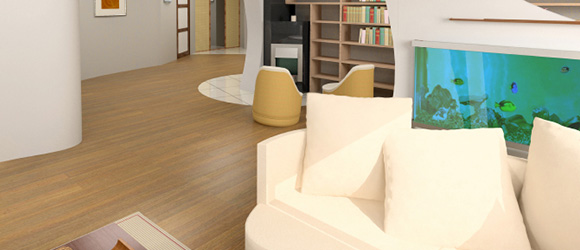Aquariums are having a modern resurgence as interior design tools for apartments and condos. Technology advances have made aquariums more user-friendly and allowed for more options than the traditional rectangular tank, as well as bringing down the general costs to aquarium ownership. This week, we got together with Blue Planet Aquarium’s Jon Wolf, to discuss these emerging trends.
1. Why is an aquarium such a versatile design tool for condos and apartments?
Modern aquariums have come a long way not only in technology to keep fish happy and healthy, but in design itself.
Take the traditional goldfish bowl for example. Boring and kind of ugly, right? Today that goldfish bowl is replaced with a unit straight out of a high-end home furnishing store, complete with filtration to keep the water crystal clear, fish healthy, and with low voltage energy efficient LED lighting for optimal viewing 24 hours a day.
Now think of the old standard rectangular tank with laminate cabinetry that doesn’t match anything in the room. Replace this with sleek modern cabinetry, high-tech lighting, and curved glass to smooth out those sharp corners. The thought process with aquariums used to be, “Don’t worry so much about what the outside of the tank look like, look at the incredible animals inside”.
Now, that thought process is completely out the window. Since the advent of IKEA, CB2 and the like, as well the rise of DIY home renovation, every person feels the need to channel their “inner interior designer,” and ugly, out-of-date aquarium design won’t cut it anymore.
2. What type of aquarium do you recommend for those wanting to dip their toes into the aquarium hobby?
There are three basic types of aquarium setups – freshwater, saltwater, and saltwater reef aquariums. The first two are pretty self explanatory; the last features less by way of fish but displays an array of live corals and invertebrates such as shrimp, sea urchins, and starfish.
A reef aquarium is often regarded as the most beautiful but most costly type of aquarium to both set up and maintain. However, if you’re just considering starting your first aquarium, the really important aspects to decide are the size and shape of the aquarium you’ll get.
If it is going to be a small tank, there are plenty of great options out there as far as off the rack kits, or even something a little more customized. However, the saltwater fish-only tank won’t be a great idea for a small tank, as its fish tend to need a little more room. Freshwater fish are born and raised in aquariums, and are generally very accepting to having many fish in a small space. The reef tank would also work out well, as you probably could only have a couple fish (for example the “Nemo” Clownfish) along with live corals, shrimp, and other interesting aquatic animals.
If it is a larger aquarium you are considering, the reef tank as a starter may be cost prohibitive. There is much more needed in terms of filtration, lighting, and additives to maintain a reef aquarium as compared to a freshwater or saltwater tank. A reef aquarium is more fragile, because you are really attempting to recreate a whole ocean ecosystem. A “fish only” type installation, on the other hand, features artificial decor which is very easy to clean and filtration that does a tremendous job of keeping the basics of water chemistry in line to keep fish healthy and happy.
3. In terms of using aquariums for interior design, what are the latest trends you’re seeing?
An extremely popular aquarium design is the “room divider” used to separate or define space, where one can see right through the aquarium into another room. Imagine replacing glass or dividing walls separating, say, a conference room from the rest of the office, a dining room from a living room, or reception desk from a lunch room, with an array of fish, crystal-clear water, and color changing LED lighting. It can have a radically transformative effect on any space.
People now are more willing to get adventurous with their aquariums – a corner aquarium can be used to draw attention to an unused part of a room, a curved aquarium (rather than the traditional rectangle shape) can mimic the curvature of a wall, and a cylindrical aquarium can be viewable from 360 degrees as a “walk around” in the center of a room.
Jon Wolf is Aquarium Design Consultant of Chicago’s Blue Planet Aquarium, which specializes in custom aquarium installations and maintenance services.



